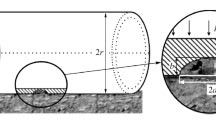Abstract
Distributions of wall thicknesses differing from their nominal values are analyzed, and factors facilitating the formation of thicknesses equal to and exceeding their nominal values are considered. It is shown that the nominal and mean thickness values calculated using the full volume of field examination data have to be used in calculating the rates of erosion-corrosion wear and predicting the service life of pipelines.
Similar content being viewed by others
References
M. Postler and J. Kaplan, “Influence of Power Update on FAC of the Secondary Circuit Piping in Czech and Slovac NPPs,” in Proceedings of the International Conference on Flow-Accelerated Corrosion, Lion, France, March 18–20, 2008.
P. Lovrencic, “FAC Program in Krsko NPP,” in Proceedings of the International Conference on Flow-Accelerated Corrosion, Lion, France, March 18–20, 2008.
V. K. Chexal (Bind) and J. S. Horowitz, “Chexal-Horowitz Flow-Accelerated Corrosion Model — Parameters and Influences,” in Current Perspective of International Conference on Pressure Vessels and Piping: Codes and Standards. Book No. 409768, 1995, pp. 231–243.
W. Kastner, V. Erve, V. Henzel, and B. Stellway, “Erosion-Corrosion in Power Plant Piping Systems Calculation Code for Predicting Wall Thinning,” in Proceedings of Specialists Meeting Organized by the International Atomic Energy Agency, September 12–14, 1998 (IAEA, Vienna, 1990), pp. 49–59.
S. H. Lee. T. R. Kim, S. C. Jeon, and K. M. Hwang, “Thinned Pipe Management Program of Korean NPPs,” in Transactions of the 17th International Conference on Structure Mechanics in Reactor Technology (SmiRT 17), Prague, Czech Republic, August 17–22, 2003, pp. 1–8.
V. I. Baranenko, S. G. Oleinik, Yu. A. Yanchenko, et al., “The Use of Software Packages for Calculating Erosion-Corrosion Wear of Components of Pipeline Systems at Nuclear Power Stations,” Teploenergetika, No. 11, 21–24 (2003) [Therm. Eng., No. 11 (2003)].
V. I. Baranenko and Yu. A. Yanchenko, “Solving the Problems of Erosion-Corrosion Wear of Equipment and Pipelines in Nuclear Power Plants: Domestic and International Experience,” Teploenergetika, No. 5, 12–19 (2007) [Therm. Eng., No. 5 (2007)].
M. Ruscak, J. Kaplan, and P. Kadeka, “Complex Approach to the Lifetime Evaluation of WWER Secondary Piping due to Erosion-Corrosion,” in Proceedings of IAEA Specialists Meeting on Erosion/Corrosion of Nuclear Power Plant Components, Vladimir, Russia, September 13–16, 1999.
J. Kaplan, “New E-C Model and Assessment, Division of Integrity and Technical Engineering Nuclear Research Institute,” in Rez. Workshop at SUJB, Prague, Czech Republic, November 7–8, 2002.
T. M. Mulayil, “On the Question of Flow-Accelerated Corrosion,” At. Tekhn. za Rubezhom, No. 12, 16–21 (2008).
I. K. Nikitina, A Handbook on Pipelines for Thermal Power Stations (Energoatomizdat, Moscow, 1983) [in Russian].
Author information
Authors and Affiliations
Additional information
Original Russian Text © V.I. Baranenko, V.M. Markochev, Yu.A. Yanchenko, 2011, published in Teploenergetika.
Rights and permissions
About this article
Cite this article
Baranenko, V.I., Markochev, V.M. & Yanchenko, Y.A. Field examination of the erosion-corrosion wear of pipelines at Russian nuclear power stations equipped with VVER reactors. Therm. Eng. 58, 404–411 (2011). https://doi.org/10.1134/S004060151105003X
Published:
Issue Date:
DOI: https://doi.org/10.1134/S004060151105003X




